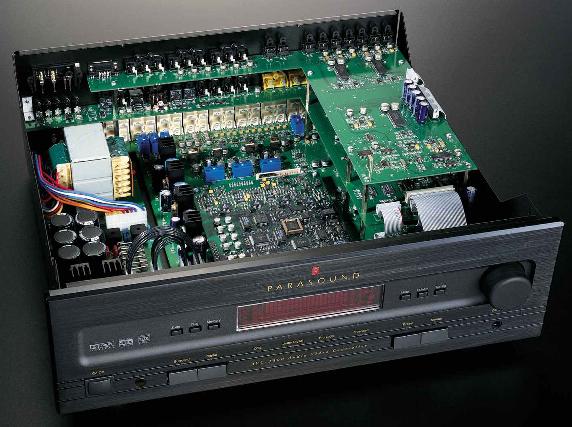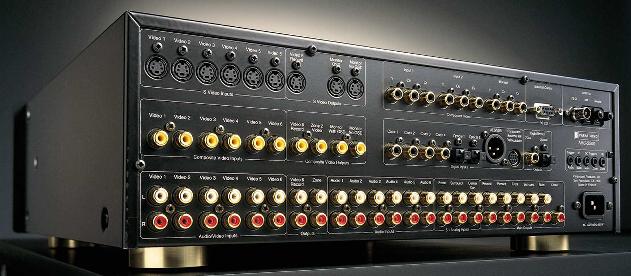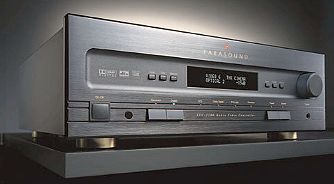Product Review - Parasound
AVC-2500 Surround Sound Processor - December, 1999
Stacey L. Spears
![]()
|
Dolby Digital, DTS, Dolby Pro Logic decoding THX-Ultra Processing FM/AM Tuner with 20 Presets Automatic System Calibration Automatic input selection, 6 audio/video inputs, each with composite and S-Video inputs; 6 audio-only inputs; 7 digital inputs (6 coax, 2 optical, 1 AES/BEU), individually assignable; 2 digital outputs (1 coax, 1 optical); 2 component video inputs, individually assignable On-Screen Display Dual Zone Control Two 12-volt Triggers Size: 5 1/4" H x 17 1/4" W x 13" D Weight: 16 Pounds MSRP: $3,495 (USA)
|
| Parasound Products, Inc., 950 Battery Street, San Francisco, California 94111; Phone 415-397-7100; 800-822-8802; Fax 415-397-0144; Web http://www.parasound.com |
Introduction
Of all the components that make up a
home theater, nothing is cooler than the surround processor.
It is the one piece that everything else revolves around.
I have had many processors in and out of my theater the last few years,
and AVC-2500 is the latest addition.
THX is responsible for the state of home theater popularity today. They brought standards and good practice that fueled the explosive growth. Today they no longer carry as much weight in most areas. For example, their DVD program is seriously lacking. In fact, its seems that a DVD with a THX logo is sometimes the sign of poor quality. (Get with the anamorphic program guys!) But for THX-certified surround processors, they offer the most basic features that really make setup easy. Most non-THX processors still do not offer some of these basic ideas, even though many of the THX-pioneered features have trickled down.
To me the most lacking feature on non-THX processors is reference 0. When you go into calibration mode, the processor is set to this reference level and you then configure your processor. Theta, for example, does not offer this basic, yet important, feature! I strongly believe in THX processors and will not own one without this certification.

It has all the goodies
The AVC-2500 is a great looking box!
It has a nice metal finish topped off with the traditional Parasound
logo. The first THX amp I ever
owned was a Parasound HCA-1206. I purchased it back in 1994. I still use it today in one of my reference theaters with the Meridian
565. It has provided me with a lot
of pleasure over the years, so I was really excited to see
this new reference processor from Parasound.
For the review I used their HCA-1205 multi-channel amplifier (a review of that
is forthcoming).
Under the hood, three Motorola 56009 DSP engines power the AVC-2500. The internal D/As are the Crystal 4390s, and the A/D is the Crystal 5360. The rated specs on the Crystal chips are impressive. The AVC-2500 is top notch inside and out.
Setup
The AVC-2500 fairly screams, �Quality!� when you take it out of the box. The build quality is excellent, and the front panel presents a very refined, minimalist user interface. The back panel offers a complete complement of high quality gold-plated connectors.
The AVC-2500 is very much ready for the future. First you have a 6-channel analog set of inputs (usually called the "5.1" input or inputs) for any future format that may come along like DVD-A and SACD. The 5.1 input is the only input that is not passed through the A/D converters before being output. Even the volume control has no effect on that input.
If you have a laserdisc player, you can add an optional RF demodulator input for $180. Compared to the RF boxes from Meridian and Lexicon, $180 is a steal. Yamaha has one for $99 (I have not compared the quality of the various RF demodulators, just the prices).
The AVC-2500 is a member of the THX Ultra program. It sports an impressive array of features and formats including Dolby Digital, DTS, and THX enhancements for both. There is one thing that it cannot do nor can it be upgraded to do and that is Dolby Surround EX. It does not have enough outputs to support it. To date, only Lexicon and Onkyo have products that support EX. Yamaha has a new EX-compatible receiver, to be released in the first quarter, 2000. I am sure others will follow.

Connections on the AVC-2500 are simple, but I was disappointed to find that after all connections were complete, I only had sound output from the surround channels. There was no audible output at all from the front left, center, or right channels. I pored over the manual to make sure I hadn�t missed some key setup feature and assured myself that all connections were correct, and finally resorted to calling Parasound�s technical support. After I answered the standard battery of questions, the technician suggested I reboot the processor by disconnecting the power, then reconnect the power while pressing the AVC-2500�s power button. He warned that I�d lose all programming, but that was a very small price to pay to get 5 channels of sound over 2. Fortunately, it worked and I was rolling. Chalk one up for Parasound technical support. As we move towards hi-fi being computer-oriented, we are going to have more and more of these types of situations, just as we do with our PCs and Macs.
The AVC-2500 has one exceedingly cool feature: automatic calibration. Parasound includes a microphone with the AVC-2500 that is used to automatically calibrate the processor�s channel levels and delay times. It really couldn�t be simpler. To calibrate the channel levels, plug in the calibration mike, navigate through the setup menus to the appropriate page, and press A. Cal on the remote. The AVC-2500 will activate its internal pink noise generator and emit a series of increasingly loud bursts from each of the five channels, adjusting each channel�s output level appropriately. The most difficult part of the whole procedure is holding the microphone still for the five-minute process. Calibrating delay times is just as simple, and when you�re done, you have a system that�s calibrated better than the average user could do manually. I have seen one other processor that shipped with a microphone, but it did not auto-calibrate the levels, much less channel delays. Chalk up another one for Parasound and the auto setup features. (Competitors should take note.) Home theater is now very complicated, sort of like where the PC was several years ago. I am currently on vacation at my parents� place in California as I write this. They have a new home theater, but it is far from set up properly, so when they put in a DVD, either the TV or the processor is always in the wrong mode. Parasound has done a Herculean job at simplifying the setup process. Without proper setup, you never really get the most from your processor. So, if you are not a hi-fi geek, you can have a high performance processor but not have to worry about all the buttons. Now that is marketing cleverness!
Bass management setup is quite flexible. For the front speakers, you choose Small/THX or Large; for the center and surround speakers you choose Small/THX, Large, or None; for subwoofer, Yes or No. A large speaker will be driven with a full-range signal. A small speaker will have low frequencies rolled of starting at (THX-specified) 80 Hz. That low frequency signal will be routed to the subwoofer, if present, or the front speakers. I would have liked to see a customizable low-frequency cutoff (low pass filter) for small speakers, ideally independent cutoff frequencies for individual channels. With all of the other configuration options available in the AVC-2500, this seems to be a strange omission, but since the 2500 is upgradeable with Internet downloads, perhaps some sort of adjustable bass management crossover frequencies are down the road.
On the video side, the AVC-2500 includes two pairs of component video inputs. This can accommodate your DVD player and an HDTV receiver. Smart move on Parasound's part. But, as always, I can find something to gripe about. The component connections are mislabeled Y, Cr, Cb. They should be Y, Pr, Pb. Cr and Cb refer to digital component. Toshiba is also guilty at this mislabeling. As I have said before, home theater is complicated, so mislabeling connections may confuse consumers.
One of the last features I will talk about is the RS-232 port. This excites me to no end! All products should have some type of communication port for the future, meaning home automation. Parasound even has the control protocol published on their website, so anyone can begin writing software today. In the coming year, we will have great new technologies like UPnP (www.upnp.org) and HomeAPI (www.homeapi.org) from Microsoft that will make it easy to tie your PCs with other consumer electronics and easily control you entire house with a single push of a button.
Dynamic Compression
One feature that I appreciate more than some might in a processor is dynamic compression, sometimes called �night listening� mode. I occasionally have guests for movies who will avail themselves of the slower sections of some films to catch a few winks. Those guests rarely appreciate the dynamics of a good system when it interrupts their naps a few winks short of 40. Dynamic compression is made for guests like those.
The AVC-2500 implements dynamic compression very well. I viewed several scenes that are guaranteed to interrupt a mid-movie nap: �The Launch� from Apollo 13 (chapter 13), �Leeloo & Mangalores� from The Fifth Element (chapter 27), �Mole Hunt� from Mission: Impossible (chapter 4), among others. In comparing the sound of each scene with and without dynamic compression engaged, I was impressed at how little sonic detail was lost with dynamic compression. There was a slight decrease in overall level when dynamic compression was engaged, but the AVC-2500 didn�t draw a veil drawn over the sound as other processors can do. Dialog was every bit as intelligible with dynamic compression as it was without (which is to say, extremely); subtle sound effects were still present. The only effect of dynamic compression was to soften the gunfire, shattering glass, and explosions, just as it should be.
These days, just about any processor can re-create a theater with precision, minus the sticky floors and the annoying people behind you. You know you have something special on your hands when it can accurately reproduce music. The AVC-2500 does not really have a lot to choose from for music modes. You have stereo, a party mode, and music mode. Music mode integrates a center channel but does not have the same multi-channel recreation sparkle as the Meridian Tri-field or Lexicon Logic-7 DSP music modes. But for straight 2-channel stereo, the AVC-2500 is a solid performer. Going head to head with the Lexicon in 2-channel mode, I give the nod to the Parasound. Once you go multi-channel though, the Lexicon hedges out the Parasound.
I listened to several of my favorite music CDs with the AVC-2500, including Holly Cole�s, �I can see clearly now.� [Don�t smoke in bed CD]. This track has some great detail buried deep within the song. It�s also ripe with sibilance. The recording room's echoes were not rendered as clearly as they are on the Meridian 861, and there was a tad more sibilance, but it was noticeably better than the Lexicon DC-2 in straight stereo. The soundstage extended way beyond the left and right speakers and deep into the room. When played in music mode, the center channel integrated well without collapsing the wide soundstage.
I followed up Holly with a little Alanis Morissette�s, �So Pure.� [Supposed former infatuation junky]. Alanis took her proper spot in the living room to sing to me.
I finished off with the wonderful voice of Aaron Neville�s singing, �Somewhere somebody.� With the volume set to near-movie reference, I never felt fatigued. I could have continued listening through the night.
And finally, the AVC-2500 has a built-in AM/FM tuner. I love listening to the radio in my car, but do not have the patience waiting for songs I like to hear while sitting around the house. Perhaps when I get a multi-room setup going, pumping my favorite FM stations through the house as background music will be welcome, but until then, its CDs and DVDs for me. However, on that note, it played STAR 101.5 and KISS 106.7 flawlessly.
As I mentioned earlier, I paired the AVC-2500 with its sister product the HCA-1205. The AVC-2500 offers a special trigger control that will turn the HCA-1205 on and off. One less button to push for me, I love that feature! My HCA-1206 is never turned off, because I am lazy. Any feature that allows me to be even lazier will receive a thumbs up from me.
Conclusion
Parasound builds robust high quality products that have proven to last many years. The AVC-2500 packs many, many features into a single box. It is ready for the future with 5.1 inputs and can be upgraded via an EPROM and its RS-232 port. It has an automated setup process that will have novice home theater users getting the same performance as the gurus. The AVC-2500 is a well thought out and well built product. Its 2-channel performance is of audiophile quality and its 5.1 channel performance is tops too.
- Stacey L. Spears -
![]()
� Copyright 1999 Secrets of Home Theater & High
Fidelity
Return to Table of Contents for this Issue.


